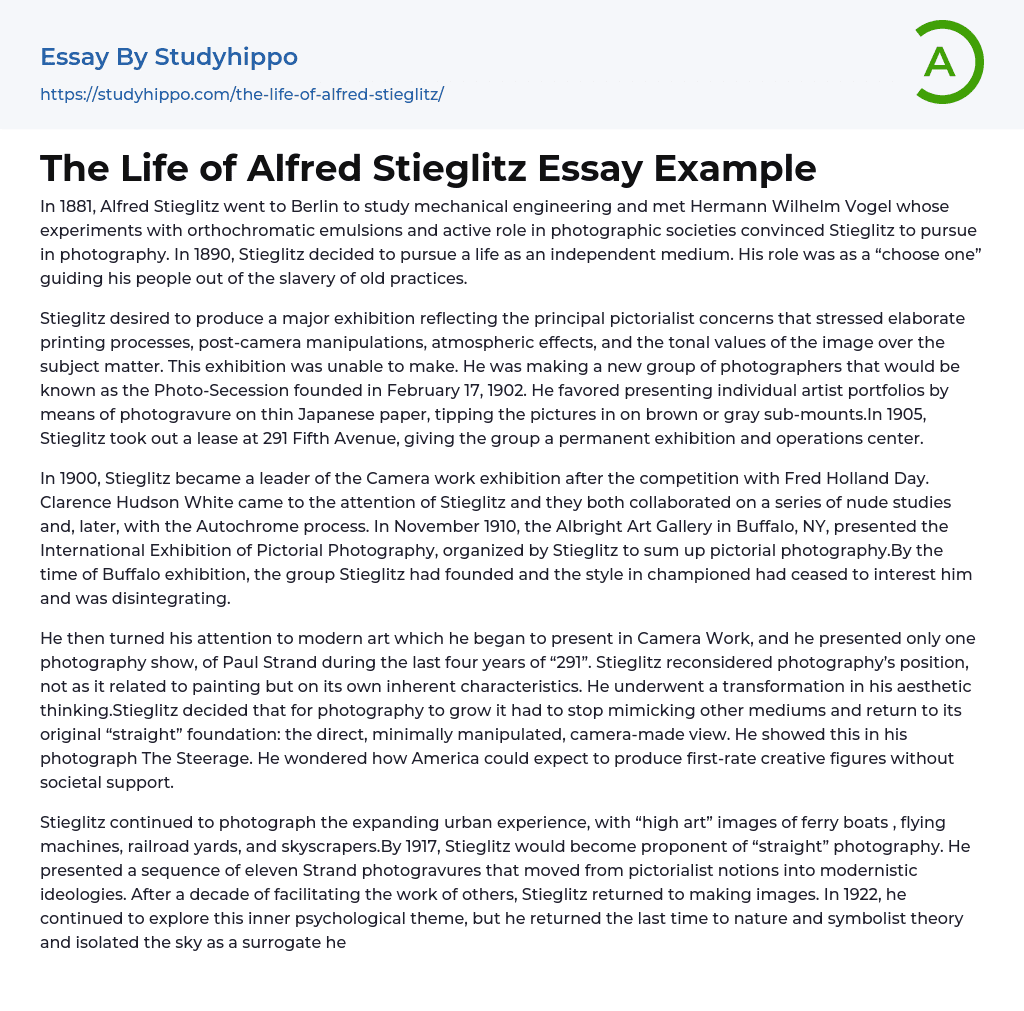In 1881, Alfred Stieglitz went to Berlin to study mechanical engineering and met Hermann Wilhelm Vogel whose experiments with orthochromatic emulsions and active role in photographic societies convinced Stieglitz to pursue in photography. In 1890, Stieglitz decided to pursue a life as an independent medium. His role was as a “choose one” guiding his people out of the slavery of old practices.
Stieglitz desired to produce a major exhibition reflecting the principal pictorialist concerns that stressed elaborate printing processes, post-camera manipulations, atmospheric effects, and the tonal values of the image over the subject matter. This exhibition was unable to make. He was making a new group of photographers that would be known as the Photo-Secession founded in February 17, 1902. He favored presenting individual artist portfolios by means of photogravure on thin Japanese pape
...r, tipping the pictures in on brown or gray sub-mounts.In 1905, Stieglitz took out a lease at 291 Fifth Avenue, giving the group a permanent exhibition and operations center.
In 1900, Stieglitz became a leader of the Camera work exhibition after the competition with Fred Holland Day. Clarence Hudson White came to the attention of Stieglitz and they both collaborated on a series of nude studies and, later, with the Autochrome process. In November 1910, the Albright Art Gallery in Buffalo, NY, presented the International Exhibition of Pictorial Photography, organized by Stieglitz to sum up pictorial photography.By the time of Buffalo exhibition, the group Stieglitz had founded and the style in championed had ceased to interest him and was disintegrating.
He then turned his attention to modern art which he began to present in Camera Work, and he presented only one photography show
of Paul Strand during the last four years of “291”. Stieglitz reconsidered photography’s position, not as it related to painting but on its own inherent characteristics. He underwent a transformation in his aesthetic thinking.Stieglitz decided that for photography to grow it had to stop mimicking other mediums and return to its original “straight” foundation: the direct, minimally manipulated, camera-made view. He showed this in his photograph The Steerage. He wondered how America could expect to produce first-rate creative figures without societal support.
Stieglitz continued to photograph the expanding urban experience, with “high art” images of ferry boats , flying machines, railroad yards, and skyscrapers.By 1917, Stieglitz would become proponent of “straight” photography. He presented a sequence of eleven Strand photogravures that moved from pictorialist notions into modernistic ideologies. After a decade of facilitating the work of others, Stieglitz returned to making images. In 1922, he continued to explore this inner psychological theme, but he returned the last time to nature and symbolist theory and isolated the sky as a surrogate heart.
He photographed skyscrapers which made him the chief photographer for Conde Nast Publicationsin 1923. Stieglitz wanted to prove that photography could have an aesthetic validity without imitating painting. He never interfered with reality often waiting for hours until "everything was in balance". He founded the "Photo-Secession" group in 1902 and managed a small gallery in New York later to be named the 291 Gallery. He introduced the works of Rodin, Cezenne, Toulouse Lautrec, Picasso, Braque and Brancusi to America.
- Family essays
- Wealth essays
- Punctuality essays
- Carpe diem essays
- Persistence essays
- Chicken essays
- Crops essays
- Object essays
- Adaptation essays
- Love Story essays
- Mystery essays
- Thank You essays
- Hero essays
- Farm essays
- Focus essays
- Development essays
- Welding essays
- Nursing essays
- Integrity essays
- Hypocrisy essays
- Mother Tongue essays
- Contrast essays
- Secret essays
- First Love essays
- Motherhood essays
- Beauty essays
- Alcohol essays
- Aging essays
- Narcissism essays
- Myself essays
- Greed essays
- Limitations essays
- Fire essays
- House essays
- Peel essays
- Evil essays
- Humility essays
- Perspective essays
- Dream essays
- Change essays
- Choices essays
- Toys essays
- Experience essays
- Wisdom essays
- Transport essays
- Barbie Doll essays
- Adversity essays
- Lifestyle essays
- Housing essays
- Holiday essays




